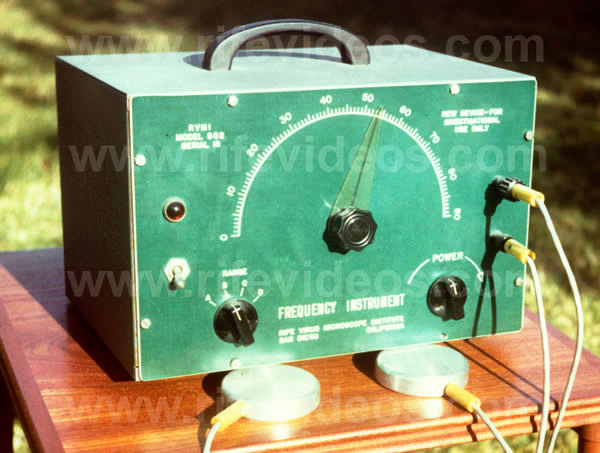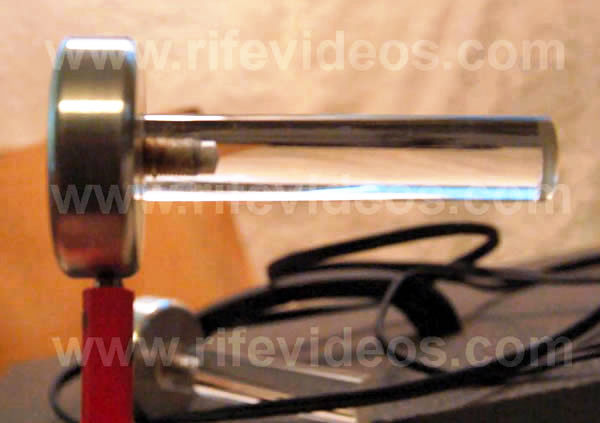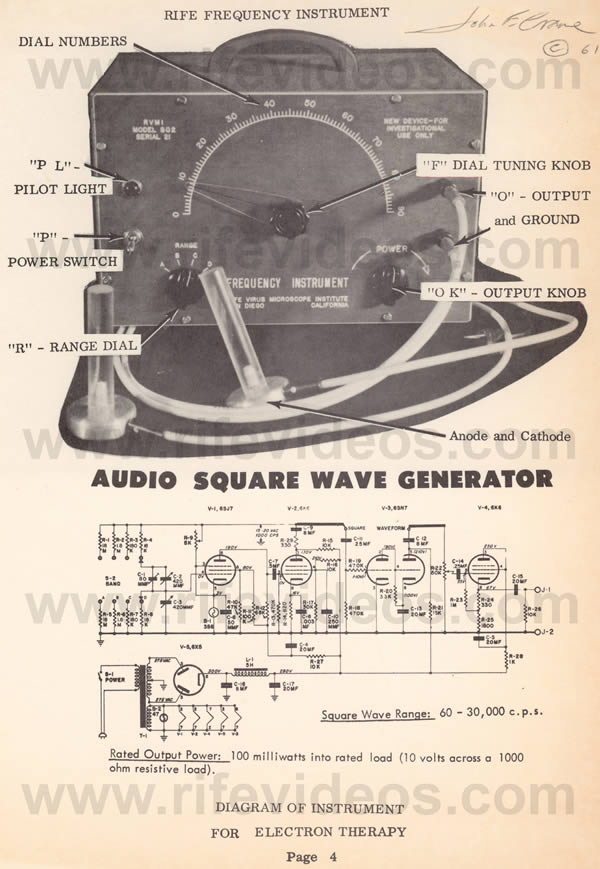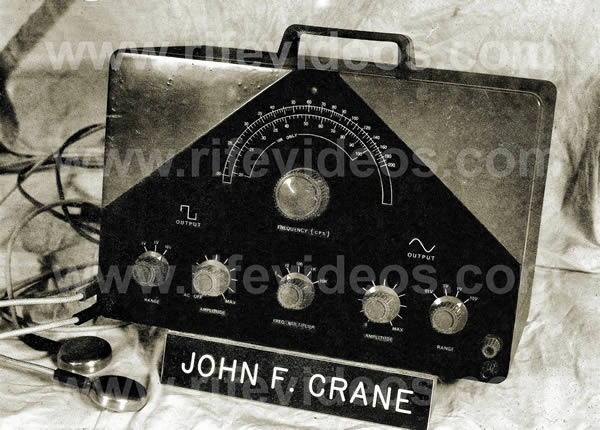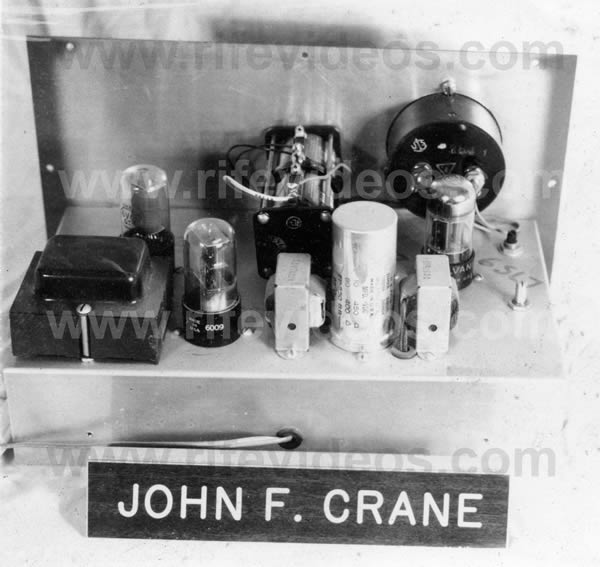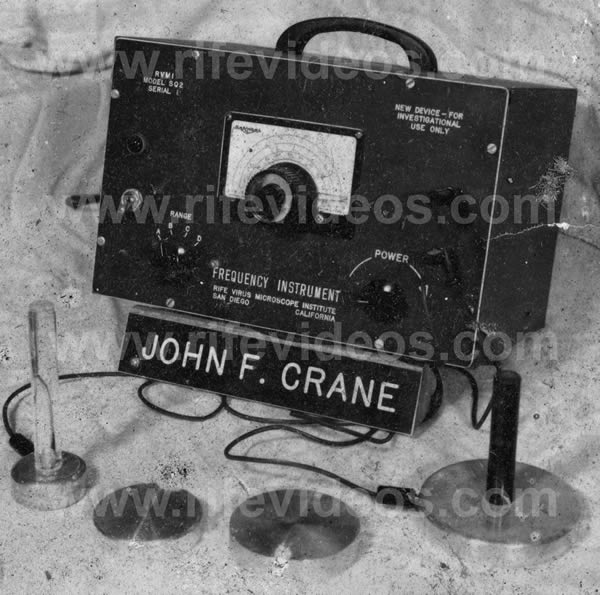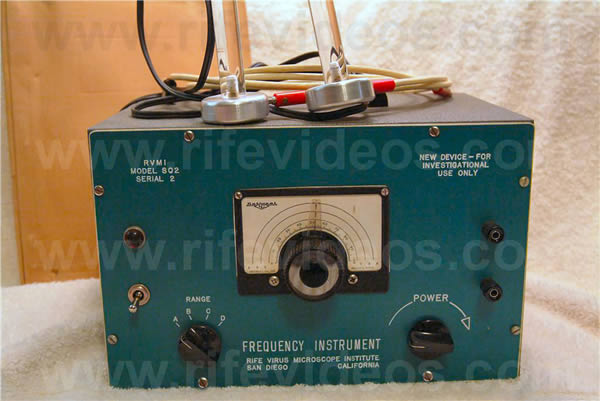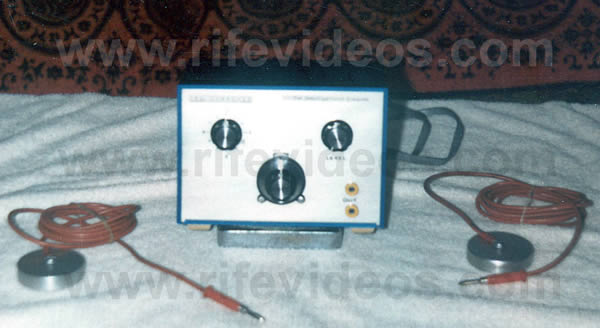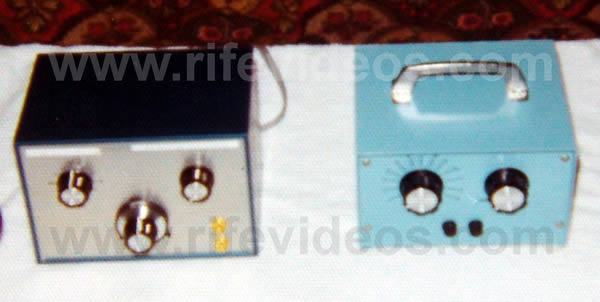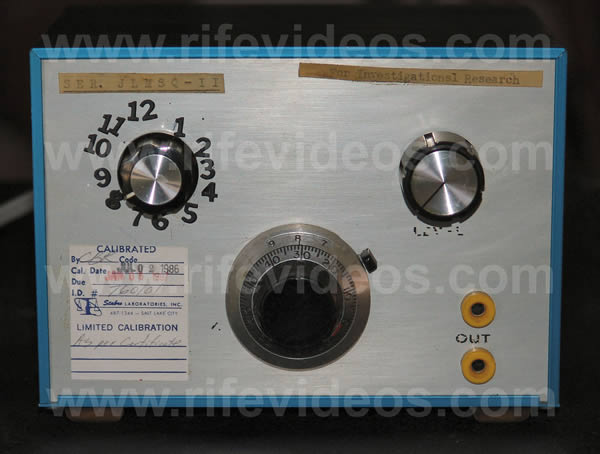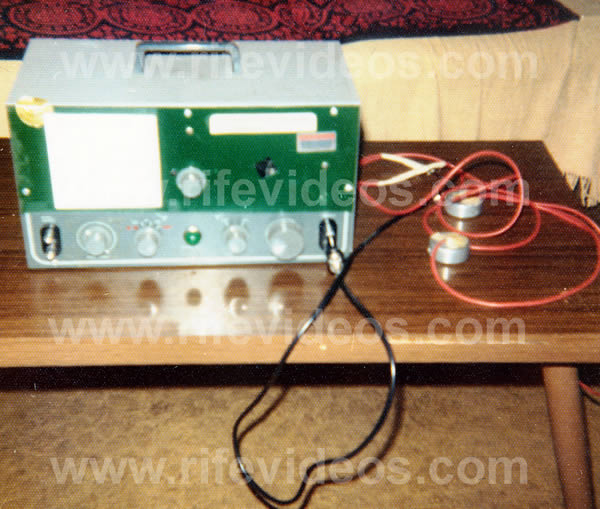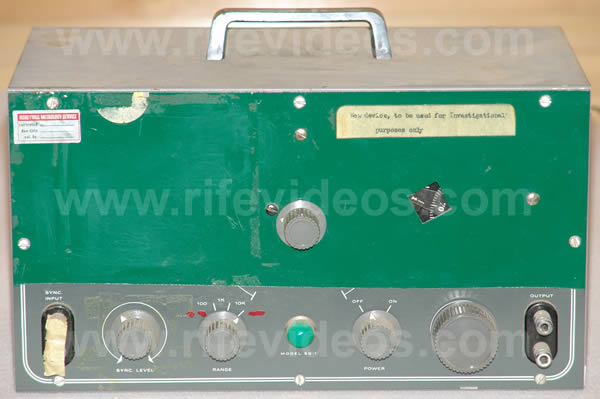| Home | Accessory Kit | Marsh CD Collection | Library | Contact Us |
Chapter #14
Life Labs 1950's Pad
Instrument without ray tube
1) Used round disks that came in contact with the body. Later changed in the 1960s to use hand-cylinders or footplates.
2) Had no RF carrier frequency. Used electrical current as a carrier.
3) Used the square wave audio frequencies used in the AZ-58.4) Power output was only about 1/10th to 1/20th of 1-watt.
It was about 1957 when John Crane and John Marsh began building instruments without a ray tube. Earlier in this article, Bertrand Comparet was quoted as saying:COMPARET: “Now, Crane said “Well now look, Rife himself admits that no matter how much tube and ray, and so on, you have, you can’t get any results unless you’ve got the right frequency. Therefore the real clue to the thing is the frequency and not the means by which you deliver it.” (1970’s Bertrand Comparet Interview #33)
John Crane and John Marsh replaced the ray tube with two aluminum disks (shown in the above photo) which they developed that came in contact with the body. As we pointed out earlier in this report it is interesting to note that Dr. Rife said Abrams’ Oscilloclast would devitalize the BX cancer virus and it was a contact type device. John Crane and John Marsh probably used this contact method because of the success of Abrams’ instrument. From the documented information we have, it was also the high cost of building ray tube instruments that caused them to look at doing things in a different way. In addition to being expensive to build, the ray tube could break very easily. They had many problems with them. It does not appear that Dr. Rife, at least in his early years, ever had a reason to look at doing things differently. John Crane and John Marsh did. They didn’t have the kind of money to spend that Dr. Rife did. They say that "Necessity is the mother of invention!"In the photo, shown below, we see that they eventually added handles onto the disks so that they were easier to use.
John Crane and John Marsh used a Heathkit function generator to produce the frequencies. These Heathkit function generators had no built-in carrier frequency on which to modulate the audio frequencies. Therefore, the RF carrier frequency was no longer used. The fact that they didn’t feel the RF carrier frequency was necessary shows that they totally believed that the audio frequencies were the M.O.R. frequencies. This also shows beyond doubt that they never knew the importance of the RF carrier frequency or had any understanding of the harmonic sideband method used in the original Rife Ray #5 or Beam Ray Clinical Rife Machine. They could have made a pad instrument work like the Beam Ray Clinical Rife Machine if they would have used a harmonic sine wave RF carrier frequency at 3,300,000 Hertz. After the many years that these pad instruments have been used it appears that the removal of the ray tube was not as important as the removal of the RF carrier frequency.
Dr. Rife would have never approved of using an instrument without an RF carrier frequency. He knew that Philip Hoyland’s Beam Ray Clinical instrument which used the sideband method somehow needed an RF carrier frequency to make it work properly. Though Dr. Rife didn’t fully understand Philip Hoyland’s instrument he clearly understood the importance of the RF carrier frequency. The positive thing about using a Heathkit function generator in this way is they were inexpensive (about $200) and a lot more people could afford one. Many people can thank John Crane and John Marsh for this innovative method. John Crane and John Marsh proved that the square wave audio frequencies worked the same whether applied through a ray tube or pads if sufficient power is used. Many people think that John Crane and John Marsh built the pad style instrument without Dr. Rife being fully informed about it. But this was not the case. John Crane and John Marsh had talked for some time about building a smaller ray tube instrument but instead of building it they built the pad style instrument. In John Marsh’s Trip to Ohio Papers we read this:RIFE: “That is the only way that it can be handled properly.”
MARSH: “Maybe we can sell small instruments for the purpose of small diseases like colds, flu and stuff like that, which are minor, which the Dr.s prefer not treating those kind anyway, because they are chronic, and there isn’t anything they can do with them. People keep coming in and coming in and they take up his time where he could spend it taking care of a bad case, or something or other. Dr. Stafford said that he would prefer that a small instrument would be made...What do you think John? I've been doing a lot of talking not even giving you a chance to get a word in edgewise.”
CRANE: “There is no doubt there is going to be an awful lot of development on this design…” (1957 John Marsh trip to Dayton, Ohio #36-38)
From these statements, we learn that Dr. Rife knew that they wanted to build small instruments. Also, we learn that it was John Marsh and John Crane’s idea to build the pad instruments, not Dr. Rife’s. We know that Dr. Rife was upset with John Crane and John Marsh over the building of these pad instruments because he expressed it to Bertrand Comparet during his 1961 deposition. Comparet said:COMPARET: “And I asked Rife, because I thought Rife would certainly say that the way Crane was working on it then was still using the Rife principle, but he indignantly denied it.”
HUBBARD: "All right, I see. But, getting back, you say that Rife was very indignant, that the machine that Crane was building was really his [Cranes] idea. I suppose he did not compromise on that, did he?
COMPARET: "Oh no, he just blew up." (1970’s Bertrand Comparet interview #32 & 40)
At this time John Crane and John Marsh were working on both the ray tube instrument and the pad type instrument. We know that Dr. Rife considered the ray tube instrument to be his instrument. The ray tube instrument used an RF carrier frequency on which the square wave audio frequencies were modulated. So it is clear that the pad type instrument without an RF carrier frequency is what Dr. Rife was upset about. It is also clear that Dr. Rife fully knew what they were doing but he did not approve of what they were doing. Because they didn’t use an RF carrier frequency the pad style instrument would not be working on Dr. Rife's principle of coordinative resonance through high RF sideband frequencies. We know that this was the method Philip Hoyland used in his design. If there is no RF carrier then there would be no sideband frequencies and this would mean that none of Dr. Rife's higher harmonic RF frequencies would have been produced. This also means the pad style instrument only worked on low square wave audio frequency harmonics not high RF frequencies. However, John Marsh and John Crane’s innovation with a pad type instrument proved that the ray tube could be removed and frequencies could be applied electrically through the contact method which they used.This new method made it possible for more people to have access to a less effective form of Dr. Rife’s technology. Though it was a less effective method many people over the years have been helped by this method of only using low square wave audio frequencies. Back when John Crane and John Marsh were building these pad type instruments they could have built a pad type instrument capable of producing all of Dr. Rife's frequencies. The reason they did not do this is due to the fact that they believed that the low square wave audio frequencies would work as well as Dr. Rife's original high RF frequencies. Time has proven that they were not correct in this belief. Today all of Dr. Rife's original high RF frequencies and the higher harmonics of those frequencies which Philip Hoyland used can be produced by any function generator with the proper frequency range of at least 1 Hertz to about 4,000,000 Hertz.
It appears that one of the reasons why John Crane and John Marsh didn’t use an RF carrier frequency is the Heathkit function generator that they used didn’t have the capability of using an RF carrier frequency. Audio frequencies will not broadcast; therefore, they are modulated upon the RF carrier frequency so that they will penetrate the body. In laymen’s terms, modulation is piggy-backing one or more low frequencies onto another higher frequency. The frequencies travel together but still keep the components of both waveforms. Almost all of the so-called "Rife Machines" built today do not use an RF carrier frequency even though Dr. Rife’s Beam Ray Clinical instrument and the 1953 AZ-58 Machine did. If Dr. Rife could have removed the RF carrier frequency from his instrument and gotten the same results, I believe he would have removed it because it would have made building an instrument a lot easier. He became upset with John Crane and John Marsh for doing this. As it is, Dr. Rife never removed the RF carrier frequency from any of his instruments. It was John Crane and John Marsh who remove it. If a person wants to try and obtain the same type of results that Dr. Rife did, then an RF carrier frequency should be considered and used with any audio frequency instrument.
We realize that there are ray tube instruments today that do not use an RF carrier frequency. These use a high electromagnetic field (EM) which will transfer the energy into the body. We do not doubt that these instruments work very well with low square wave audio frequencies. We have talked with people that are using these instruments and they say that they are getting very good results. But these instruments are still using just the low square wave audio frequencies without an RF carrier frequency. What we are talking about in this report is the way that Dr. Rife used RF frequencies and an RF carrier frequency modulated with an audio frequency to produce the proper sideband method. Some of these EM ray tube instrument builders like to compare EM devices to RF devices. This is like comparing apples and oranges. There is no comparison because if you do not have an RF carrier frequency then you cannot create any sideband frequencies. The EM devices work on a high electromagnetic field, the stronger the better. RF devices work on radio frequencies and the power output is measured in watts. Dr. Rife’s instruments were all RF instruments and could resonate with an organism when the proper RF frequency was used. EM devices use low audio frequencies because they cannot output RF frequencies. RF versus EM or apples and oranges cannot be compared because they are two totally different principles. EM devices are also limited in their frequency range. Usually, they can only output frequencies to about 20,000 Hertz where Dr. Rife's RF devices were putting out frequencies in the millions of Hertz or cycles per second.
There is some misinformation being put out about pad instruments. Mostly it is done by people who believe that only a ray tube will work in delivering frequencies to the body, whether it is through the RF or the EM method of delivering frequencies. These people promote the false belief that audio frequencies, when used in a pad instrument without an RF carrier or without an EM field, will only travel along the surface of the skin of the body. They say that the frequencies cannot penetrate the body because of the "Skin Effect." We need to point out that the "Skin Effect" has nothing to do with human tissue or human skin. The "Skin Effect" has to do with the skin or surface of a metal conductor such as a copper wire. If the human body was made of metal then the "Skin Effect" would apply. These people are either totally ignorant or willfully trying to mislead people so that they will only purchase an instrument that uses a ray tube. What we should really believe is what the scientific tests have proven in regards to the "Skin Effect" as it pertains to human or animal tissue.
In scientific studies called "Bioelectric Impedance Analysis," it has been shown that sine wave audio frequencies, without an RF carrier frequency, will enter the body but will only travel in the connective tissues around the cells. These tests have proved beyond doubt that the frequency does go right through the skin contrary to what people have claimed. Also in these scientific studies, it has been shown that the closer you get to 1 Megahertz the greater the penetration of the current through the cell. At 1 Megahertz or one million Hertz, the current of the frequency will go through the cell and fully penetrate the body. These types of tests show why it is very important that an RF carrier frequency is used. A virus can enter a cell and live there. An RF frequency can enter the cell where it can do the most good. These kinds of scientific studies and their importance were not understood by John Crane and John Marsh in the 1950s and 1960s. These "Bioelectric Impedance scientific tests also prove that what many people have been saying about the "Skin Effect" is absolutely false. In this Rife machine report, we do not ask people to believe what has been said without proof. For this reason, we have included one of these scientific reports for you to read. There are other reports on the web that you can read but we found that this one is the easiest to understand. But even with that said, unless you have some understanding of how electricity works then it may be difficult for some people to understand. It is, for this reason, an explanation in blue type print is given at the end of each section.
(To read one of these "Bioelectic Impedance Analysis" studies click on these words).
Below is a schematic of John Crane & John Marsh’s pad instrument. It was nothing more than an off-the-shelf audio frequency generator with the faceplate changed. There was nothing special about this frequency generator because any common function generator can do the same thing that this one could do. There have been people who have copied this instrument and who charge enormous sums of money for a replica. As much as four or five thousand dollars. They claim that this is a real genuine Rife Machine. Do not be fooled. The same audio frequencies that were used in the 1953 AZ-58 were also used with this instrument. Those frequencies were 120, 660, 712, 727, 776, 784, 800, 803, 880, 1552, 1862, 2008, and 2128.
Below are several photographs of the many pad type frequency generators that John Crane and John Marsh built. The first one was built by John Crane.
These next three photos, shown below, are of another one of John Crane's pad type instruments.
The next two photos, shown below, are of the pad style instrument built back in 1961 by John Crane and John Marsh. They at that time were calling their organization the "Rife Virus Microscope Institute". This name is on the front of their instrument. The first photo is from back in 1961 and the second photo is a new photo of one of these instruments which survived
The next two photos, shown below, are pictures of one of John Marsh's pad instruments which he built in the 1980s. The first photo is from the 1980s and shows the aluminum disks which he was using at that time. The second photo shows this same instrument with another pad instrument that he built.
The next photo, shown below, is a new photo take of an instrument that John Marsh owned and gave to his nurse. It is similar to the instrument shown in the first photo above of John's instruments.
The next two photos, shown below, are of a pad machine that John Marsh made out of a 1950's Heathkit frequency generator. Almost all of the pad type machines that both John Crane and John Marsh built were really made from off-the-shelf frequency generators without any changes being made to them. Many times they would either replace the faceplate with their own or they would cover it so that no one would know that they were just using an off-the-shelf frequency generator. Above shown in one of the photos of John Crane's machine you can see that he covered the original faceplate so no one would know what he was doing. In the next two photos, you can see that John Marsh did the same thing with this one. The first photo was taken by John in the 1980s and the second photo is a new photo of this instrument.
Chapter Summary: Pad type audio frequency instruments have done a lot of good over the years. But without an RF carrier frequency properly match with the correct audio frequencies Philip Hoyland's sideband method cannot be used with them. These instruments need to have an RF carrier frequency or the ability to output the exact frequency that Dr. Rife used. We know from the documents that Dr. Rife preferred using the exact frequency rather than Philip Hoyland’s sideband method, but either method will work and Dr. Rife used both. Dr. Rife’s frequency range included both the audio range and the RF range of frequencies from 1 Hertz to about 1,800,000 Hertz. Philip Hoyland's design produced higher harmonic frequencies of Dr. Rife's original frequencies in the 2,000,000 and 3,000,000 Hertz range.
The so-called pad "Rife Machines” that are sold today which cannot produce these frequency ranges cannot produce Dr. Rife's results. Make sure that the frequency generator you purchase can produce both the audio and RF frequencies that Dr. Rife used. Also, it should be understood that the pad type instruments are not able to output the power that the ray tube instruments can. Pad style instruments that do not use an RF carrier frequency or the higher RF frequency range generally do not exceed one half of one watt of power. This is because the body cannot take more than about one-fifth (1/5th 0.20) of one-watt before the electrical current begins to lock up the muscles of the user. When an RF carrier frequency is used then the body does not react to the electricity and this makes it so that higher power levels can be used up to the 15 to the 18-watt range. Dr. Rife's ray tube instruments had power ranges from 50 to 500 watts output. The Rife Ray #5 or Beam Ray Clinical instrument power output was 75-watts.
In chapter 15, we will look at a ray tube instrument built by John Marsh in the 1970's.

